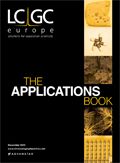Simultaneous Quantification of 2- and 4-Methylimidazoles in Beverages Using a Simple Filter and Shoot (FASt) Procedure
The Application Notebook
UCT, LLC
2-methylimidazole (2-MeI) and 4-methylimidazole (4-MeI) are by-products from the manufacture of caramel colour additives used in beverages, soy sauces, baked foods, and so on. The International Agency of Research of Cancer classified these two compounds as "possibly carcinogenic to humans", and proposed the no significant risk level (NSRL) to be 29 µg/day for 4-MeI, while California listed 4-MeI as a probable carcinogen and proposed a 16 µg/day NSRL. This application note presents a simple, fast, and cost-effective method to determine 2-MeI and 4-MeI in beverages simultaneously. Beverage samples were degassed, diluted 10 times with acetonitrile (MeCN), and filtered through a solid-phase extraction (SPE) cartridge with 200 mg FASt sorbent, onto which the undesired matrix components, such as sugars and organic acids were retained, while the analytes were passed through and collected. A new HILIC HPLC method was developed to separate the 2-MeI and 4-MeI isomers, which underwent the same MS–MS transitions. Baseline separation was achieved in an 8-min run.

Procedure
1. Sample pretreatment
Pour the beverage samples into 500-mL beakers, and degas the samples by stirring at high speed for 2 h.
2. Filter and Shoot (FASt) procedure
a. Transfer 0.1 mL of the degassed samples into test tubes or vials. Add 0.9 mL of MeCN and 100 ng/mL imidazole as internal standard (IS). Vortex for 10 s.
b. Attach the FASt cartridges (CSFAS203) to a glass block or positive pressure manifold, insert test tubes or 2-mL auto-sampler vials into the manifold.
c. Transfer the entire diluted samples into the cartridges, apply low vacuum or positive pressure, and collect the filtrates.
d. The samples are ready for LC–MS–MS analysis.
Instrumental
LC–MS–MS: Thermo Scientific Ultimate 3000® LC coupled to Vantage MS/MS system
Injection: 10 µL at 10 °C
LC column: Thermo Scientific Accucore HILIC, 100 × 2.1 mm (2.6 µm), with 10 mm guard column
Column temperature: 40 °C
Mobile phase: 8-min isocratic with 5% of 50 mM ammonium formate in water and 95% of MeCN
Flow: 0.4 mL/min
Polarity: ESI positive
Collision gas: Argon at 0.8 mTorr
Retention times and MS–MS transitions:
a. IS: 1.96 min; 69.07→42.01; 69.07→28.08
b. 4-MeI: 3.18 min; 83.08→56.05; 83.08→42.00
c. 2-MeI: 5.72 min; 83.07→42.04; 83.07→56.05
Results
This efficient and reliable FASt procedure has been applied to the analysis of 12 real samples, including one colourless naturallyflavoured soda, one root beer, one sweet tea, and nine colas of the same brand obtained from nine different states in the USA (AZ, CO, LA, MD, MS, OR, TN, TX, and WA). 2-MeI was not detected in any of the samples, while 4-MeI was detected in 11 of the samples. The only exception was the colourless soda, which was therfore used to prepare matrix matched calibration standards and spiked samples. The nine cola samples from the different states were found to contain 4-MeI at varying levels; the lowest result of about 100 ng/mL was detected in the samples from WA and OR, while the highest of 840 ng/mL was from AZ.

Table 1: Accuracy and precision data.
Conclusions
A simple, fast, and cost-effective method has been developed for the simultaneous quantification of 2-MeI and 4-MeI in beverage samples utilizing a filter and shoot procedure. Excellent recovery (103.6% and 102.9% for 4-MeI and 2-MeI, respectively) with RSD less than 5% was obtained. An 8-min HILIC HPLC method was successfully developed for the baseline separation of the 2-MeI and 4-MeI isomers with identical MS–MS transitions.

UCT, LLC
2731 Bartram Road, Bristol, Pennsylvania19007, USA
Tel: (800) 385 3153
E-mail: methods@unitedchem.com
Website: www.unitedchem.com

Analytical Challenges in Measuring Migration from Food Contact Materials
November 2nd 2015Food contact materials contain low molecular weight additives and processing aids which can migrate into foods leading to trace levels of contamination. Food safety is ensured through regulations, comprising compositional controls and migration limits, which present a significant analytical challenge to the food industry to ensure compliance and demonstrate due diligence. Of the various analytical approaches, LC-MS/MS has proved to be an essential tool in monitoring migration of target compounds into foods, and more sophisticated approaches such as LC-high resolution MS (Orbitrap) are being increasingly used for untargeted analysis to monitor non-intentionally added substances. This podcast will provide an overview to this area, illustrated with various applications showing current approaches being employed.








